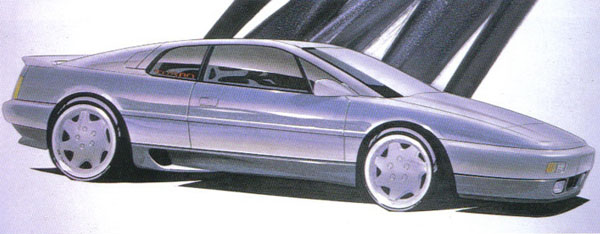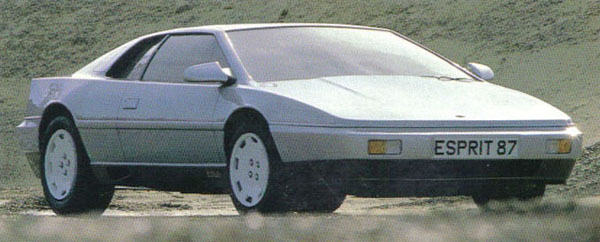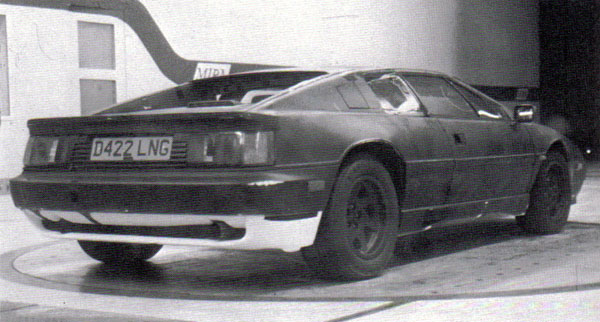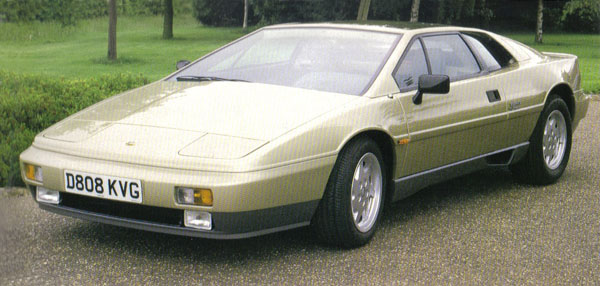
Click on image to enlarge

Lotus Esprit X180 Concept Car
The New Esprit – Lotus Design’s First Creation
Peter Stevens the Chief Designer
Norwich lies approximately
150 km north-east of London in the county of Norfolk. Lotus has had
its headquarters in the rural part of England since 1966. It was here
in November 1985 that sketch and clay model presentation for the next
generation Esprit were presented to Senior Management. It was approved
for production by the Lotus board in January 1986, immediately following
the acquisition of Lotus by General Motors.
As Readers will know, the first series Esprit which debuted 12 years
ago (a mock up being shown at the Turin Show 16 years ago in 1972)
was a Giugiaro design. That he continued to maintain good relations
with Lotus there after was clearly evident for the shape of the Lotus
Etna concept model displayed at the Birmingham Show in 1984. Etna
was developed with the support of Chief Executive Mike Kimberley,
who took over the reigns of management at Lotus after the death of
it’s founder Colin Chapman. Giugiaro was not the only Designer
to be working with Lotus at the time, however. Another was Peter Stevens,
who was featured in issue 49 of CAR STYLING.
Stevens turned freelance when he left Ogle Design in 1975, and worked
for a large number of Clients, one of which was Lotus. His facelift
proposal for the Excel went into volume production with practically
no changes made to it, and he has been treated as a Lotus employee
ever since.
Before there was any design organisation at Lotus Engineering Ltd,
the development arm of Group Lotus Plc, Stevens started work on the
development of the new Esprit with the assistance of the Lotus engineers.
Lotus Design was inaugurated in June 1986, after the clay model of
the new car had been approved. Julian Thomson and Simon Cox (whose
graduation works were introduced in issues 48 and 57 of CAR STYLING
respectively), who like Stevens are RCA graduates, joined Lotus at
the time, and Andy Harrison moved across from the engineering division
where he had been a trim Designer.
Kimberley set the development team an August 1, 1987 target for getting
the revised Esprit into production. Volume production development
was completed in just 19 months after model approval, and the car
had its debut on schedule at the London Motor Fair in October. “The
success of this program is a result of the Lotus philosophy of using
a small dedicated team of Designers and engineers working closely
with one another in a parallel process of development, rather than
a sequential program,” relates Stevens. Put the other way, he
is saying that the project would not have been so successful if the
help of a designer outside the company had been sought. While Stevens
did not make any express reference to it, one reason for Lotus not
using Giugiaro can probably be found here.
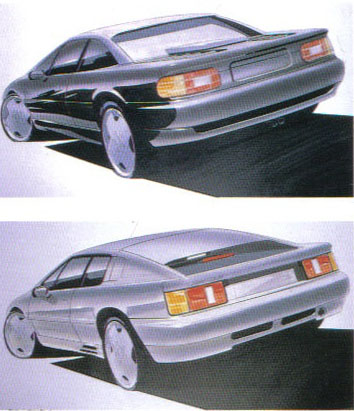
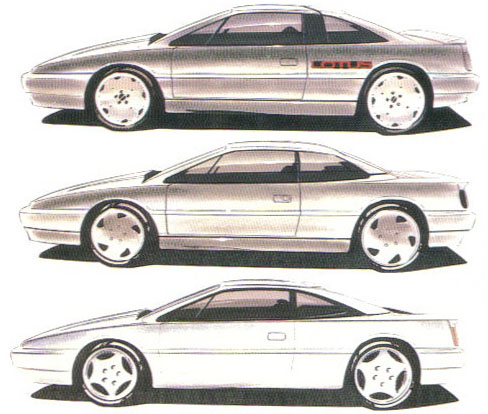
From line to surface
The revised model has a shape which is readily identifiable as an Esprit, and it retains the image of its predecessor quite clearly. Nor does Stevens deny this, “The design objective was not to produce a totally new car, but rather to attend to a number of design improvements identified before the project started. The Giugiaro designed car still has an excellent overall stance and proportion, and observing the restraint of using an almost identical backbone chassis, we had only limited latitude in radically changing the shape of the car.”
Click on image to enlarge
Final rendering the of Esprit Turbo by Julian Thomson

To retain the excellent proportions of its predecessor, Stevens kept exactly the same A-pillar angle in the new car. While in its individual parts it may not resemble the first series Esprit too closely, the fact that it projects a “very much an Esprit” impression when seen overall is probably due to the A-pillar. This is one key point in the design of the new model. Another lies in the differences between the old and new models. To borrow Steven’s description, “ The new Esprit can be seen as being of a “line” dominated car, and more as a surface derived car.” It is not simply a question of softening the shape, the whole styling basis has changed from line to surface. As a result of the diminished presence of the strong lines and edges, the Esprit has evolved into a soft and slippery looking shape. This visual softening has actually contributed to the overall stiffness of the body since the edges no longer act as structural hinges between the planes.
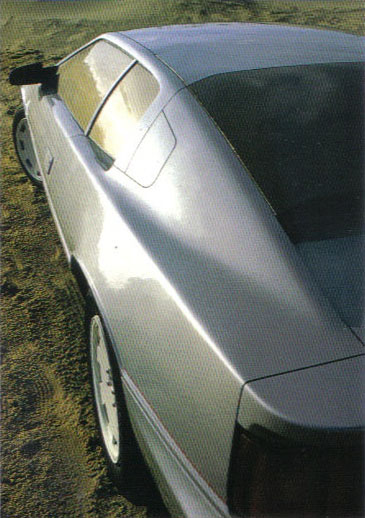
Click on image to enlarge
Aero stability
The revised Esprit comes in three variants; Turbocharged and normally
aspirated models for Europe, and a Turbocharged version for American.
Basically they all have the same body, but the Cd and CI values vary
since the air intakes, rear design and rear lover valance differ from
model to model.
Esprit Model
Normally Aspirated: Cd 0.350, Clf 0.089, Clr 0.114
Esprit Turbo Domestic : Cd 0.335, Clf 0.055, Clr 0.075
Esprit Turbo Federal: Cd 0.345, Clf 0.062, Clr 0.091
Turbo variants have a glass panel attached to the of the rear deck
forming an extension of the roof, and this is the principal factor
that their figures are superior to those of the normally aspirated
model. When one considers, however, that the first Esprit had a published
Cd of 0.34, the 0.335 figure for the best revised model hardly merits
much praise. According to Stevens, however, “The previous Esprit
had, in the course of time, been eroded to a Cd of 0.40.” Compare
with this, the 0.335 figure represents a some 20 per cent improvement.
By that as it may, priority in the development of the new Esprit’s
aerodynamic characteristics was given to achieving good aero stability
- the aerodynamic stability when wind direction or vehicle attitude
changes – rather than the out and out pursuit of a really low
Cd. One aim here was to make the Cd and lift less sensitive to pitching
though the improvement of areas criticized in the old Esprit.
“Lotus believes that any increase in either front or rear lift
as yaw angle increases should be linear and that the front and rear
values of Cl should, if possible, remain parallel or converge when
represented graphically,” explains Stevens, who goes on to add,
“We tool Cl values at 1-degree steps up to a maximum of 15 degrees,
since it is possible to have what appears to be a linear graph using
5-degree steps taht actually has a severe swerve in it that is only
shown by 1-degree steps.” Stevens and his team spent approximately
250 hours in the MIRA and St. Cyr before they were satisfied.
The new Esprit undergoing testing in the MIRA windtunnel
Interior continues image
At first glance, the interior also strongly resembles that of the
old Esprit. The basic composition of the dashboard – a separate
instrument binnacle mounted on a slopping fascia, with the switch
gear on either side of this – remains unchanged. The binnacle,
however, has been designed with a smaller and visually lighter form,
while instrumentation is now by V.D.O. The steering wheel on the Turbo
has a new 3 spoke design which “we developed jointly with the
test driver.” Says Stevens. The normally aspirated version has
a 2 spoke design as did the old Esprit. The new binnacle does create
a feeling of greater space in the cabin, which, in fact, has 20mm
more headroom and 15mm more legroom. The seats are 25mm wider.
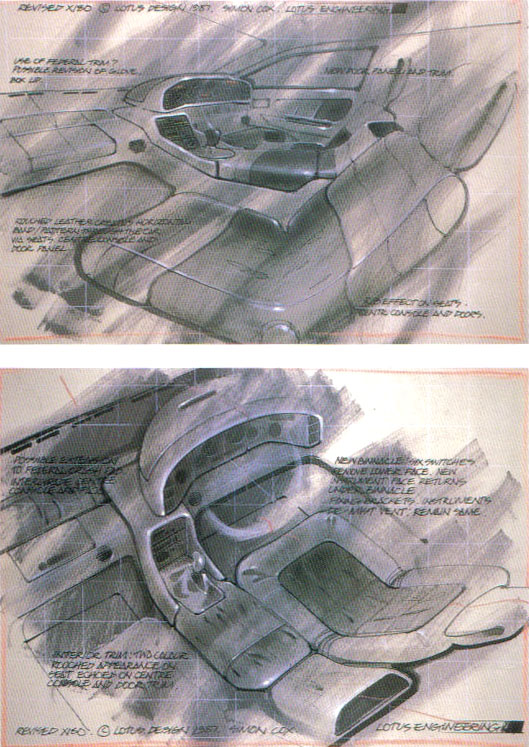
Interior rendering drawn by Simon Cox
The revised Esprit could be described as the fruit of accumulated
efforts to realize small improvements, and contemporary design techniques.
The who expect the redesign of a supercar to produce something more
dramatic may well be dissatisfied. The only changes which really stand
out are, in the chassis, the switch from a Citroen to Renault transmission
and, because of this, the moving of the rear brakes outboard (not
on American models), while in the engine department, there is a new
water-cooled turbo charger with integral waste-gate. There is little
major innovation on the mechanicals either. One wonders whether buyers
of this type of car will be satisfied merely with a drastic change
in the exterior appearance? There again, from the viewpoint which
argues that because it is a supercar, great importance should be attached
to tradition and reputation in order to preserve identity, it is desirable,
as long as it bears the Esprit name, that it have styling which plainly
identifies it as an Esprit. What gives cause for concern with this
facelift is the possibility that in some people’s eyes Lotus
may appear a conservative manufacturer. This impression, however,
is almost certain to be swept away by the totally new Lotus that Stevens
and the rest of Lotus Design are working on at present.
Click on image to enlarge
Running Protoype Lotus Esprit X180


Photo of the Lotus Design staff at the London Motor Show, where the new Esprit had its first public debut. From left: Andy Harrison (Trim), Julian Thomson (Exterior), Peter Stevens (Chief Designer) and Simon Cox (Interior).
Thanks to Wayne Barratt for the article

